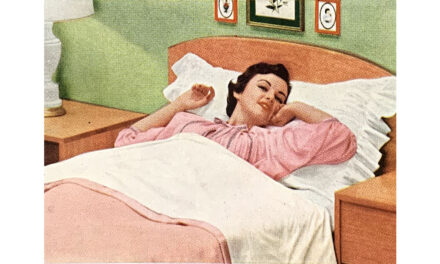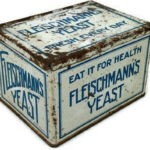First there were ice-houses;
then there were ice-boxes;
then there were refrigerators.
Only refrigerators had problems getting grid of the melt-water. It became ice on the inside walls of the refrigerator.
That’s what makes this advertisement for Gibson Refrigerators so special: this model came with automatic defrosting! Gibson was one of the first manufacturers to sell refrigerators with automatic defrosting.

Fifty years before this 1953 advertisement appeared in Good Housekeeping magazine, Frank Gibson expanded his company that manufactured insulated wooden ice-boxes. The two-compartment boxes were lined with tin or zinc. Blocks of ice sat in the lower compartment and food stayed cool on the shelves in the compartment above. A drip pan collected the melt-water—and it had to be emptied daily.
Gibson called them “ice refrigerators” and his company became the largest manufacturers in the ice-box business at that time. In 1918 William C. Durant started the Frigidaire Company to mass-produce refrigerators based on Alfred Mellowes’ invention of a self-contained refrigerator, with a compressor on the bottom of the cabinet that replaced the block of ice. Durant was better known as a pioneer in the automobile industry. You can read about him in this post on our Printing Times website.
In 1931, Gibson began making electric refrigerators.
While getting rid of
the ice-box melt-water
was messy, getting rid of the ice that formed in electric refrigerators was a major problem. Defrosting the fridge was a chore!
Here’s the routine:
Get some absorbent clothes, old towels are usually preferred, and a large bowl or two for hot water.
Unplug the fridge and take out all the food. Find a place for it on the kitchen tables and countertops. Take out the shelves if that is possible—they may be held tightly by the ice on the refrigerator walls.
Place the bowls of hot water in the fridge to help the ice-removal along but do not chip, scrape or pry at the frost build-up. And do not use a heat source such as a blow dryer because that could damage the plastic interior of the refrigerator. You can even try washing the ice with hot wet clothes.
Be sure to put more towels on the floor.
When the ice is all gone, clean the inside of the refrigerator with soap and water. Ideally you will allow the fridge to air dry for at least an hour because wet walls will frost quickly.
Once the refrigerator is completely dry you can put back the food that has been sitting on the kitchen counter for the last hour or more.
It took time. It was troublesome—but not as bad as defrosting the freezer!
Gibson didn’t solve the defrosting problem—Westinghouse did, early in the 1950s, when they developed automatic defrosting.
A Westinghouse refrigerator advertisement in the Canton Repository newspaper, September, 12, 1951, read:
“Only Westinghouse Frost-Free Dares To Offer You A 30-Day Money-Back Guarantee. We’re so dead sure you’ll agree that Westinghouse Frost-Free is the world’s finest completely automatic refrigerator that we’ll make you this amazing proposition: If, within 30 days after you buy a Westinghouse Frost-Free Refrigerator from us, you’re not 100% satisfied, we’ll take it back and refund your full purchase price. It won’t cost you a cent — no delivery or removal charge, absolutely nothing.
“You can’t lose, so why wait? So, learn now without risk what hundreds of thousands of homemakers have found … Westinghouse Frost-Free means no defrosting work or mess or bother ever again! You just plug it in, set the control dial and forget it!
“Order your Frost-Free today and you’ll have it tomorrow. You can be sure, if it’s Westinghouse.”
The Gibson advertisement above says very little about automatic defrosting. The focus instead is on the other features
It practically hands you the food … this beautiful new Gibson Refrigerator with “Swing-out Servers”! Meat locker, 2 crispers and shelf—they all swing right to you!
And oh lady, wait’ll see all the other wonders of this nothing-like-it Gibson! Automatic defrosting, big full-width freezer, door racks and butter storer—everything to make this the handiest, roomiest, most efficient refrigerator you ever dreamed of!
So don’t miss this new Gibson beauty with the new “cameo-Cream” interior before you make your choice. Visit your Gibson dealer —now!
When homeowners couldn’t afford refrigerators with automatic defrosting
they could buy either the Paragon “de-frost-it” for $9.95
or the D‑FROST-O-MATIC for $12.95 installed.



Here are links to TV commercials from the fifties for Westinghouse refrigerators, featuring spokeswoman Betty Furness.
And don’t miss this live 1954 commercial for a Westinghouse refrigerator where the spokeswoman June Graham, was substituting for Ms. Furness. It was live: she was unflappable!
The Cameo-Cream interior of the Gibson refrigerator was only one of several pastel colors – like turquoise and pink – popular on some models in the late 1960s. Earth tone colours – Harvest Gold, Avocado Green and Almond – were popular exterior colors throughout the 1970s.









